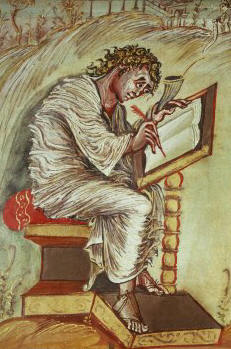Popular Questions About Renaissance Art
History
What is the difference
between Italian Renaissance art and Northern Renaissance art?
How did the Black
Death impact European art history?
How did the Inquisition
impact European art history?
What was the
influence of the Medici
Academy on Renaissance painters?
What was the
Bonfire of the Vanities?
Who were the greatest
painters of the Renaissance?
Search:: Artists Alphabetically Artists by Country Artists by Century Artists by Movement
|
Carolingian Manuscript Illumination Under Charles the Bald, Carolingian illumination reached its highest point of excellence. The most important scriptoriums were the Tours, Rheims, and Metz monasteries. The style has its roots in the Lombard-Saxon style. Principal features of Carolingian Manuscript Illumination intertwining bands and knots classical botanical elements beardless figures finely written minuscule, mainly Saxon, script capitals and columns of classic origin ornamental details sumptuous rich silver and gold leaf architectural details in the Roman manner Masterworks of Carolingian Illumination Vivien Bible The Golden Gospels of St. Médard of Soissons Alcuin Bible
Ebbo Gospels. St. Matthew, done in the Shivering Style, c. 824 illuminated Gospel Book, from the Carolingian Era. Carolingian manuscripts are masterpieces of art. Combing a variety of artistic influences. According to author J. Henry Middleton, "One important characteristic of the Carolingian manuscripts is their extreme splendour. The freely used burnished gold is often made more magnificent by the contrast of no less brilliant silver. Purple-stained vellum was largely used, and all the pigments are of the most gorgeous hues that great technical skill could produce. And yet in spite of all this magnificence of shining metals and bright colours the effect is never harsh or gaudy, owing to the taste and judgment shown by the illuminators in the way they broke up their colours, avoiding large unrelieved masses, and in the arrangement of the colours so as to give a general effect of harmony in spite of the great chromatic force of the separate parts." |
If you feel you have worthwhile information you would like to contribute we would love to hear from you. We collect proverbs and old sayings from folks all over the globe and appreciate your participation. When submitting please, if possible, site the source and provide English translation. Email to historyofpainter@gmail.com
© HistoryofPainters.com 2017
If you like this page and wish to share it, you are welcome to link to it, with our thanks.

